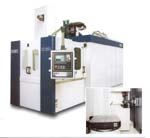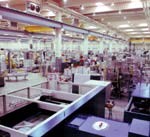Getting To Know Grob
With some familiar names in the machine tool building business fading away recently through mergers, acquisitions, or shutdowns, it may be interesting to learn of an unfamiliar or little known machine tool builder.
Share


Takumi USA
Featured Content
View More

Hwacheon Machinery America, Inc.
Featured Content
View More




With some familiar names in the machine tool building business fading away recently through mergers, acquisitions, or shutdowns, it may be interesting to learn of an unfamiliar or little known machine tool builder. This company is Grob Systems, Inc., with U.S. sales offices and a manufacturing facility in Bluffton, Ohio, roughly half way between Dayton and Toledo.
Grob builds horizontal machining centers, flexible machining systems, transfer machines and automated assembly systems. Although its horizontal machining centers are stand-alone units that might find the perfect home in a precision job shop, all of Grob's customers are the big auto makers such as Ford, General Motors and DaimlerChrysler in the United States and all of the big automakers in Europe. These machines are key elements in highly engineered systems, where the flexibility and productivity of a horizontal machining center suit today's strategy for multi-purpose, reconfigurable manufacturing resources. The company briefly considered entering the general machining center market when strong sales of such machines made such a move tempting in the mid 1990s. Instead, the company stayed wholly committed to serving its traditional automotive customers.
Grob Systems is part of a privately held company headquartered in Mindelheim, a small city in the Bavarian section of Germany. The German parent company was founded in Munich in 1926 and began building thread milling machines in 1933, eventually focusing on special machine tools. In 1952, the company began building transfer lines. Long before other machine tool builders considered investing in overseas production facilities, Grob founded a plant in Brazil in 1956 to serve the growing manufacturing industry in South America. The U.S. facility opened in 1983 and manufacturing commenced there in 1991.
Today, the company has about 180 employees in the United States, with 250,000 square feet of manufacturing space. The plant in Bluffton designs, engineers, builds and tests flexible machining systems and assembly systems. Major components, such as the machining centers and assembly modules, are built in Germany. In keeping with the strong tradition of apprenticeship programs in Germany, the Grob plant in Bluffton has a thriving apprenticeship program of its own. About a dozen apprentices are participating in this technical training program at any one time, working to complete 8,000 hours of training necessary to become journeyman tool and die makers.
Grob's main advantage is technical. The company can supply machining and assembly equipment in an integrated system and be responsible as the single source for this complex technology, taking a part from raw casting to fully assembled component ready for installation. However, it takes more than technical acumen to succeed. Understanding the market is also essential. The U.S. arm of the company has been unusually sensitive to U.S. market nuances, which contrast with Germany and the rest of Europe in many critical ways. For example, says Grob Systems Inc. president Michael Hutecker, submitting proposals to U.S. auto companies is unlike the process overseas. U.S. customers usually want proposals to be submitted in less time, with less detail and analysis and greater emphasis on process concepts. Detailed engineering is expected to be completed after the contract is awarded.
Likewise, U.S. customers have a different attitude about service and spare parts. European customers are more likely to want to maintain their own inventory of repair and spare parts, as well as have their own employees trained to do maintenance and repair in-house. In the United States, customers expect the supplier to provide round-the-clock availability of spare parts and send in repair people upon request. In the States, workers assigned to the line tend to shift from work station to work station, creating a greater training challenge, whereas their European counterparts tend to stay with one machine, getting to know its operation and maintenance more thoroughly. According to Mr. Hutecker, these differences do not affect the success of a system, but they do influence how Grob manages its customer relations. It appears that Grob has avoided some of the missteps other overseas suppliers have made when approaching the U.S. market.
A closer look at the company's horizontal machining centers is revealing. Although these machines make up only a fraction of what the company produces, they represent a technological response to the trend away from dedicated systems. A machining center can be retooled and moved as a production line is reconfigured, an important consideration given today's shorter product life cycles and demand for fast time to market. Even so, the line includes a wide range of models from the compact BZ 400 with a 400 by 400 mm pallet to the heavy duty BZ 1600 with a 1,600 by 1,600 mm pallet. Several models in the mid-size range can be ordered with linear motors. Spindle speeds can be as high as 24,000 rpm for aluminum. Tool adapters are HSK-A 63, HSK-A 80 or HSK-A 100.
Of special interest are the double-spindle horizontal machines. These machines lend themselves to applications where higher throughput for high volume parts with less variability among them is a top concern. These machines can be configured to suit automatic or manual loading and unloading and to accommodate different work positioning requirements. Because these machines make effective use of floor space, they are very popular overseas.
Also worth noting are the company's pioneering efforts to develop "dry" machining techniques. Currently, Grob has developed a system for the BZ 520 double-spindle machine. The machining center is designed to remove metal effectively with "minimal quantity lubrication," that is, a very fine oil mist. The machine is equipped with an oil mist device that delivers the mist through the tool, a special lining to direct chips freely to the conveyor, and thermal isolation of machine components to minimize the unwanted effect of warm chips on machine performance. Grob estimates that conventional flood coolant usage contributes to about 10 percent of the overall cost of producing parts. By eliminating flood coolant, dry machining can substantially reduce overall costs, the company says. At the moment, European companies have been quicker to embrace this process than the United States.
All machining centers are supplied with cutting tools and workholding fixtures as complete solutions. Grob builds its own gantries and conveyors to link machining centers into FMSs.
Company officials report a steady growth in revenues in recent years, despite the business slowdown. Since the company introduced its machining centers, it has delivered almost 500 machines for stand-alone use, more than 750 for FMSs, and more than 300 for flexible transfer systems. Not bad for a machine tool builder you rarely hear about.
Related Content
High RPM Spindles: 5 Advantages for 5-axis CNC Machines
Explore five crucial ways equipping 5-axis CNC machines with Air Turbine Spindles® can achieve the speeds necessary to overcome manufacturing challenges.
Read MoreOrthopedic Event Discusses Manufacturing Strategies
At the seminar, representatives from multiple companies discussed strategies for making orthopedic devices accurately and efficiently.
Read MoreLean Approach to Automated Machine Tending Delivers Quicker Paths to Success
Almost any shop can automate at least some of its production, even in low-volume, high-mix applications. The key to getting started is finding the simplest solutions that fit your requirements. It helps to work with an automation partner that understands your needs.
Read More5 Tips for Running a Profitable Aerospace Shop
Aerospace machining is a demanding and competitive sector of manufacturing, but this shop demonstrates five ways to find aerospace success.
Read MoreRead Next
Registration Now Open for the Precision Machining Technology Show (PMTS) 2025
The precision machining industry’s premier event returns to Cleveland, OH, April 1-3.
Read MoreBuilding Out a Foundation for Student Machinists
Autodesk and Haas have teamed up to produce an introductory course for students that covers the basics of CAD, CAM and CNC while providing them with a portfolio part.
Read More5 Rules of Thumb for Buying CNC Machine Tools
Use these tips to carefully plan your machine tool purchases and to avoid regretting your decision later.
Read More





















































